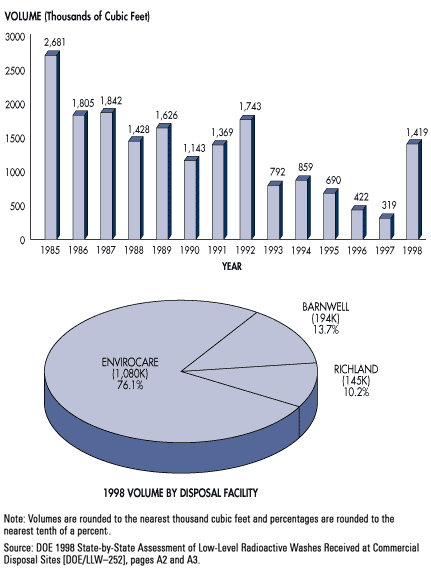According to the U.S. Nuclear Regulatory Commission (2004), LLRW consists of discarded items that have become contaminated with radioactive material or have become radioactive through exposure to neutron radiation. Trash, protective clothing, and used laboratory glassware make up all but about 3 percent of LLRW. These "Class A" wastes remain hazardous for less than 100 years. "Class B" wastes, consisting of water purification filters and ion exchange resins used to clean contaminated water at nuclear power plants, remain hazardous for up to 300 years. "Class C" wastes, such as metal parts of decommissioned nuclear reactors, constitute less than 1 percent of all LLRW, but remain dangerous for up to 500 years.
The danger of exposure to LLRW varies widely according to the types and concentration of radioactive material contained in the waste. Low level waste containing some radioactive materials used in medical research, for example, is not particularly hazardous unless inhaled or consumed, and a person can stand near it without shielding. On the other hand, exposure to LLRW contaminated by processing water at a reactor can lead to death or an increased risk of cancer (U.S. Nuclear Regulatory Commission, n.d.).

Production trends and destinations of low level radioactive waste.
| Year | Volume (Thousands of Cubic Feet) |
|---|---|
| 1985 | 2,681 |
| 1986 | 1,805 |
| 1987 | 1,842 |
| 1988 | 1,428 |
| 1989 | 1,626 |
| 1990 | 1143 |
| 1991 | 1369 |
| 1992 | 1743 |
| 1993 | 792 |
| 1994 | 859 |
| 1995 | 690 |
| 1996 | 422 |
| 1997 | 319 |
| 1998 | 1,419 |
Destinations
| Facility | Column | Percent |
|---|---|---|
| Envirocare | 1,080K | 76.1 |
| Barnwell | 194K | 13.7 |
| Richland | 145K | 10.2 |
Note: Volumes are rounded to the nearest thousand cubic feet and percentages are rounded to the nearest tenth of a percent
Source: DOE 1998 State-by-State Assessment of Low-level Radioactive Washes Received at Commercial Disposal Sites (DOE/LLW-252), pages A2 and A3.
Hundreds of nuclear facilities across the country produce LLRW, but only a very few disposal sites are currently willing to store it. As of 2012, only three sites are licensed to accept LLWR (Locations of Low-Level Waste Disposal Facilities). Disposal facilities at Clive, UT; Barnwell, SC; and Richland, WA accepted over 4,000,000 cubic feet of LLRW in both 2005 and 2006, up from 1,419,000 cubic feet in 1998. By 2008, the volume had dropped to just over 2,000,000 cubic feet (U.S. Nuclear Regulatory Commission, 2011a). Sources include nuclear reactors, industrial users, government sources (other than nuclear weapons sites), and academic and medical facilities. (We have a small nuclear reactor here at Penn State that is used by students in graduate and undergraduate nuclear engineering classes. It is the longest operating research reactor in the country, in operation since August, 1955.)